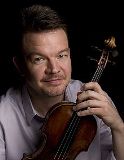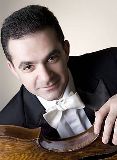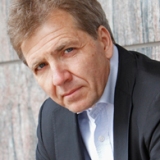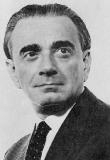
Lees, Finkelshteyn Gripping in CSO Collaboration
(first published in the Cincinnati Enquirer March 11, 2012)


That wasn’t Charlton Heston and Stephen Boyd onstage at
Music Hall Friday night. And they weren’t
chariot racing. It was Cincinnati Symphony Orchestra concertmaster Timothy
Lees and principal cellist Ilya Finkelshteyn performing the Sinfonia
Concertante for Violin, Cello and Orchestra by Miklós Rózsa. Led with precision and skill by guest conductor Thierry Fischer, it was a CSO premiere.

The composer of 97
film scores, including the Oscar-winning “Ben Hur” (referenced above via Heston
and Boyd), Hungarian born Rózsa
also wrote symphonic and chamber music.
His Sinfonia Concertante (1966) was written for violinist Jascha Heifetz
and cellist Gregor Piatigorsky.
Apparently, the two men disagreed over how it was written -- chiefly as
to whether the cello was favored over the violin – and never performed it in
its entirety.

There was no such problem for the CSO colleagues, who joined in a superb collaboration. It was by far the highlight of the program, which also included the Chaconne from Partita No. 2 in D Minor, BWV 1004, by Bach, as orchestrated by Leopold Stokowski, and Brahms’ Symphony No. 3.
Begun at the same time as “Ben Hur,” Rózsa’s Sinfonia Concertante is part Hungarian, part Hollywood, kind of goulash with glitz. In three movements and about 30 minutes long, it is scored for large orchestra, including harp, celeste and a battery of percussion. After a quick lick of snare drum, Finkelshteyn led off with the opening theme of the first movement, a simple four-note motif threaded throughout the work, followed by Lees in imitation. It was high energy music, with the sweep of an epic film score, flavored now and then with tinkles of celeste and triangle. The cadenzas (in the first and last movements) were more than just technical workouts, but inherently musical.
Finkelshteyn also opened the second movement (Rózsa’s choice of cello over violin supposedly irritated Heifetz), his velvet touch immediately setting a romantic mood. The Hungarian-flavored theme re-appeared in variations that were spritely, ardent and even film noir in mood, all colored by Rózsa’s masterful orchestration. The final bars were dreamy, violin and cello drifting off to the accompaniment of harp and trills by woodwinds and strings.
The finale, Allegro con brio, took off with a bang. Violin and cello were evenly matched in what might indeed have suggested chariot races, interrupted by a lovely, lyrical episode. The music also conjured the silver screen near the end, where the use of muted trumpet calls sounded right out of “Ben Hur.” Audience reception was warm and enthusiastic. Can the Brahms’ Double Concerto be far behind for Lees and Finkelshteyn?
The Brahms on Friday’s program, his Symphony No. 3, was curiously lackluster by comparison. Fischer, now in his second season as music director of the Utah Symphony, favored understatement at the expense of affective contrast. There was a persistent sameness about it, at least until the finale, where he finally pulled out the stops. Even there, however, there was a feeling of too little, too late. Not that Fischer didn’t exert himself, but the results were not commensurate with his effort. The “halo” at the end, with muted strings and soft statements by winds and brass, lost maximum effectiveness as a result.
The Bach/Stokowski Chaconne, which opened the concert, was a demonstration of the former CSO music director’s formidable skill as an orchestrator (Stokowski headed the CSO from 1909-12). Though engrossing in detail, it, like the Brahms, was less effective overall than it could have been. Again, it seemed more a matter of pacing than anything else. The cellos framed the work beautifully and there was fine work by the CSO winds.
It was Stokowski who spurred the construction of Emery Auditorium for the CSO (its home from 1911-1936, when it moved to Music Hall). That venue, originally 2,200 seats, now more like 1,600, would have been far more appropriate for Friday’s concert, which drew a tiny audience, especially by 3,400-seat Music Hall standards (guesstimate: 800-900 scattered all over the huge hall). One was reminded that “revitalizing” Music Hall, now projected to happen in 2014-15, including a significant reduction in seating capacity, is critically needed.
The concert repeats at 8 p.m. tonight at Music Hall. Tickets begin at $10, at the Music Hall box office. Call (513) 381-3300, or visit www.cincinnatisymphony.org